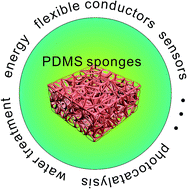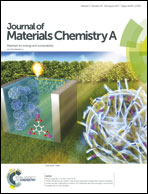Recent progress in fabrication and application of polydimethylsiloxane sponges
Abstract
Owing to their structural advantages in comparison with bulk polydimethylsiloxane (PDMS), porous 3D substrates, which are also known as PDMS sponges, possess immense potential in energy generation, transport and storage, absorption, separation, photocatalysis, wearable electronics and life science applications. Extensive effort has therefore been devoted to the design and synthesis of porous PDMS sponges. The key to excellent performance in high-value applications is a deep knowledge of the beneficial aspects of their porosity, structure and morphology for a specific application. Several new routes for the fabrication of PDMS sponges, as well as novel applications, have been developed recently. Therefore, this review focuses on advances in the field of the fabrication and application of PDMS sponges since 2011. After a concise introduction, which includes remarks on the benefits of PDMS in comparison with other materials, strategies for the synthesis/fabrication of PDMS sponges are presented and their advantages and drawbacks are concisely discussed. A summary of the potential fabrication procedures will be beneficial for those entering the field, as it gives a quick overview of the feasible applications of a PDMS sponge fabricated via a specific method. Afterwards, different high-value applications of PDMS sponges are described in conjunction with specific and detailed examples of all the abovementioned applications. In this regard, suggestions are also made regarding which fabrication method is most beneficial for the application being discussed. Finally, recent advances in the fabrication and application of PDMS sponges are summarized, as well as issues, such as surface functionalization and pore size limitations, which are impeding reasonable future applications. We envision that this review will be helpful to those entering the field, as well as experienced researchers who need rapid access to recent literature, and will give new stimuli for the development of novel porous materials.

- This article is part of the themed collection: Recent Review Articles


 Please wait while we load your content...
Please wait while we load your content...